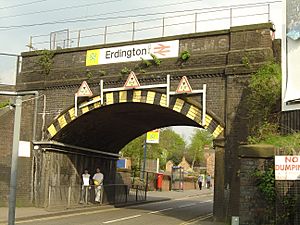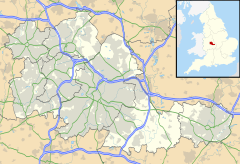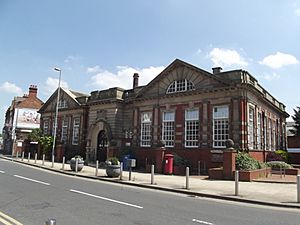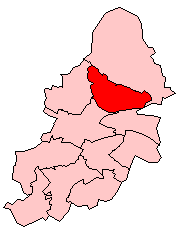Erdington facts for kids
Quick facts for kids Erdington |
|
|---|---|
St Barnabas' Church, Erdington |
|
| Population | 22,828 (2011Ward) |
| • Density | 4,910 per km² |
| OS grid reference | SP111919 |
| Metropolitan borough | |
| Metropolitan county | |
| Region | |
| Country | England |
| Sovereign state | United Kingdom |
| Post town | BIRMINGHAM |
| Postcode district | B23, B24 |
| Dialling code | 0121 |
| Police | West Midlands |
| Fire | West Midlands |
| Ambulance | West Midlands |
| EU Parliament | West Midlands |
| UK Parliament |
|
Erdington is a town and area in Birmingham, England. It's located about 5 miles (8 km) northeast of central Birmingham. Long ago, it was part of Warwickshire. Erdington borders Sutton Coldfield. It's a busy place with a mix of homes and shops.
Contents
History of Erdington
Erdington's Old Manor House
Erdington used to have its own big house called Erdington Hall. This house was like a small castle. It had a double moat (a ditch filled with water) on three sides. The River Tame protected the fourth side. An Anglo-Saxon named Eardwulf built the first fortified home here. This was near an area called Bromford.
The original hall was taken down in the 1600s. It stood on a hill where Wheelwright Road and Tyburn Road are now. The moat was drained in the 1700s. A later building on the site was removed in 1912. This made way for Tyburn Road.
How Erdington Grew in the Middle Ages
Erdington started as a village around the 800s. Settlers came along the River Tame from Tamworth. Other nearby places like Minworth also began this way. An old Roman road, now Chester Road, also brought settlers. The first part of the village was very close to this road.
When the Normans took over England, King William I gave Erdington to a powerful baron. This baron then gave the land to Peter de Erdington. Erdington was even mentioned in the Domesday Book. This old book listed all the lands in England. It said Erdington had land for farming, a mill, and meadows.
Erdington was near Sutton Forest. The Normans had strict rules about hunting there. But later, these rules became less strict. The old mill was in Bromford. It helped grind corn for the villagers.
In the 1400s, a small church was built near the manor house. But not many people went there. So, people were asked to go to the main church in Aston.
Erdington in Tudor Times
Around the 1500s, an area called Gravelly Hill became important. It was known for its sandy soil and many rabbits. At the bottom of Gravelly Hill was the River Tame. A bridge called Salford Bridge crossed the river here. This bridge was first mentioned in the 1200s. It was improved in 1810 for vehicles.
During the 1600s, new families lived at Erdington Hall. The Dymocks were a well-known family. But their strict rules made them unpopular with the local people.
Erdington During the English Civil War
The English Civil War began in the 1640s. Erdington was growing fast then, with more land being farmed. In 1643, Prince Rupert and his Royalist soldiers passed through Erdington. They were on their way to Lichfield.
Erdington in the 1700s and 1800s
In the 1700s, new roads were built. This made Erdington a popular stop for stage coaches. These coaches traveled along Chester Road from London to Chester. In 1783, the Birmingham-Fazeley Canal was finished. It ran along the edge of Erdington.
By the mid-1700s, Erdington had about 700 people. It had many roads, farms, and cottages. By 1832, the population grew to 2,000.
In 1894, Erdington became its own local district. Its offices were at the Rookery on Kingsbury Road. This area is now Rookery Park. In 1911, Erdington joined the growing city of Birmingham. The main shopping area of Erdington grew around the High Street. The railway also helped new Victorian and Edwardian houses to be built.
Highcroft Hospital's History
Highcroft Hospital was once a large hospital for people needing special care. It was built between 1869 and 1871. The building was first a workhouse. It provided housing for poor people, travelers, and those who were elderly or had mental health needs.
Over the years, the hospital changed its name. It became Erdington House in 1912 and then Highcroft Hall Hospital in 1942. It was usually called Highcroft Hospital. It mostly cared for people with mental health conditions. In 1996, the main building closed. It was empty for eight years. Then, it was made into fancy apartments called Highcroft Hall.
Lyndhurst Estate's Story
In 1957, some houses on Sutton Road were taken down. This was to build the Lyndhurst Estate. This estate included tall apartment buildings called tower blocks. Harlech Tower was the tallest at 16 storeys. In 1961, the estate won an award for its design. It kept the old trees and had modern-looking tower blocks.
The Lyndhurst estate has been updated since then. Some of the old buildings were taken down. New homes were built, and the remaining tower blocks were made new again.
What's in a Name?
The name Erdington was written as Hardintone in the Domesday Book. But most people agree it comes from an old Anglo-Saxon name. It means a strong home built by Eardwulf. The word 'ton' or 'tun' was an old English word for a settlement. This home grew into Erdington Hall.
Another idea is that the name "Yenton" comes from "Yerdington." This could mean an enclosed area, like a moated home.
Cool Places and Features
Erdington has many interesting places that show its history. One of the most famous is Spaghetti Junction. This huge road interchange is on the edge of Erdington. It's where two railway lines, three canals, and two rivers all meet! Britain's longest bridge, Bromford Viaduct, starts here. It carries the M6 motorway.
Fort Dunlop: A Piece of History
Near Spaghetti Junction is Fort Dunlop. This used to be a huge factory for Dunlop Rubber. It was a big part of Erdington's industrial past. At its busiest, 10,000 people worked there. The factory closed in 2014.
The main building was made into offices and shops from 2005 to 2006. The area around Fort Dunlop is now used by delivery companies. It also has car showrooms, including Birmingham's only Lamborghini dealership.
Shopping in Erdington
The Fort Shopping Park is named after Fort Dunlop. It was built in 1996. Erdington also has a busy town centre, or "village," called Erdington High Street. There's a market on Barnabas Road. Another market, Wilton Market, is between Sutton New Road and the High Street. Next to Wilton Market is Swannies, which is like a mix of a market and a shopping centre.
Other Places in Central Erdington
On the High Street, you'll find Erdington Parish Church. Nearby on Sutton Road is The Abbey Church. The original Abbey building is now part of Highclare School. The Parish Church was badly damaged by fire in 2007. But it has been fully repaired and updated.
Erdington Swimming Baths used to be on Mason Road. Now, a new leisure centre and baths are on Orphanage Road. Erdington Library opened in 1907. It's a public library run by Birmingham City Council. The Erdington Historical Society meets there every month.
Other Places in Erdington
Schools The Josiah Mason Campus is part of Birmingham Metropolitan College. It used to be a college called Josiah Mason College. Before that, there were two grammar schools and another secondary school on the site.
Community Facilities To the north of Erdington is Pype Hayes Park and Pype Hayes Hall. This was once the home of the Bagot family. A smaller park nearby is Sorrel Park.
The Old Green Man pub on Bromford Lane is now called the Lad in the Lane. It's one of the oldest pubs in Birmingham. Another pub, the 'Charlie Hall', is named after a famous actor from Birmingham.
In 2017, a new sports centre opened. It cost £7.5 million. It has a 25-metre swimming pool, a teaching pool, a gym, and a community room.
Hospitals in Erdington
Erdington is served by Good Hope Hospital in nearby Sutton Coldfield. It also has the Birmingham Hospice. Northcroft Hospital is built near the old Highcroft Hospital site.
Where is Erdington?
Erdington is about 4 miles (6 km) northeast of Birmingham City Centre. It borders areas like Aston, Perry Barr, and Hodge Hill. It's also close to the nicer areas of Sutton Coldfield and Castle Bromwich.
The borders of Erdington include:
- Boldmere, via Chester Road.
- Stockland Green, which borders Witton.
- The Yenton and Chester Road, which form the border from Wylde Green.
- Tyburn Road, which leads to Spaghetti Junction.
- Minworth and Curdworth at the northeast end of Kingsbury Road.
Erdington also includes Pype Hayes. This area used to have many council houses built between the two World Wars. These houses had to be taken down. Now, Pype Hayes has modern homes. One tall building, Sorrel House, was kept and made new.
Brookvale Park Lake is a park that used to be a drinking water reservoir. The city grew, and the water became unsafe. It was briefly an outdoor pool, but that also closed.
In 1981, two tornadoes touched down in Birmingham. One of them hit Erdington. It caused some damage across the northern parts of Birmingham.
People and Numbers
In 2001, there were 22,626 people living in Erdington. The area is about 446 hectares (about 1.7 square miles). Erdington had slightly more females than males. Most people (98.6%) lived in homes, not in group places.
There were about 10,547 homes in Erdington. On average, 2.2 people lived in each home. Most homes (63.4%) were owned by the people living in them. The most common type of home was a semi-detached house.
The age of people in Erdington is similar to the rest of England. About 29.7% of residents were between 25 and 44 years old. About 19% were old enough to get a pension.
Most people in Erdington (89%) are white. Black ethnic groups were the second largest (3.9%). About 8.9% of people were born outside the UK.
Most people (71%) in Erdington said they were Christian. About 14.9% said they had no religion.
The unemployment rate in Erdington was 8.1%. This was lower than the Birmingham average. Most people (65.5%) were working or looking for work. Many people worked in manufacturing.
Erdington's most famous resident was Josiah Mason. He was a kind person who gave money to good causes. His statue is now in the middle of a roundabout. He started an orphanage there in 1860.
Getting Around Erdington

Erdington railway station is on the Cross-City Line. This line goes north to Lichfield and south to Redditch. The station opened in 1862. Two other stations, Gravelly Hill and Chester Road, also serve Erdington.
Important roads in the area include the A38 (Birmingham to Derby road) and the A5127. The M6 motorway runs along the southern edge of Erdington. There are many bus routes that connect Erdington to Birmingham city centre and Sutton Coldfield.
The Birmingham Fazeley Canal and the River Tame helped Erdington become an important industrial area long ago.
Politics in Erdington
The Labour Party has often represented Erdington. However, in recent years, the Conservative party has also won seats.
The area is now divided into several wards. These include Erdington, Pype Hayes, and Gravelly Hill. The main town centre is mostly in the new, smaller Erdington ward.
Birmingham Erdington is a special area that elects one person to the UK Parliament. This person is currently Paulette Hamilton from the Labour Party.
Fun and Sports
Erdington was once home to a famous rock music club called Mothers. From 1968 to 1971, famous bands like Pink Floyd, Led Zeppelin, and The Who played there. The local band The Moody Blues were often there. The club was above a furniture store on the High Street. Other local artists included The Spencer Davis Group and Black Sabbath.
Erdington has its own football club, Erdington United. It also has a rugby union club called Erdington RFC. This club focuses on helping young players.
Erdington has two cricket teams: Highcroft and Great Barr Unity, and Erdington Court. There's also a Gaelic football and hurling team, Erin Go Bragh. The Birmingham Bulls, an American Football team, are also based here.
Famous People from Erdington
Many well-known people have connections to Erdington:
- Gabriel Agbonlahor, a football player for Aston Villa F.C..
- Havergal Brian, a composer.
- Ryan Cartwright, an actor.
- Paul Devlin (footballer), a football player.
- Leon Edwards, a professional mixed martial artist and UFC champion.
- Victor Johnson, an Olympic gold medalist in cycling.
- John Lodge (musician) and Mike Pinder, founding members of The Moody Blues.
- Jeff Lynne, singer and songwriter from Electric Light Orchestra (ELO).
- John Oliver, host of Last Week Tonight with John Oliver.
- Martin Shaw, a well-known actor.
- Murray Walker, a famous motorsport commentator.
Images for kids





